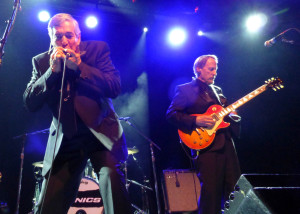The Sonics documentary: A sonic boom of nostalgia… sort of

“Boom: A Film About the Sonics.”
“Boom: A Film About the Sonics” is the long-awaited documentary about the formidable garage-rock band from Tacoma, Wash.
“Boom: A Film About the Sonics”
Director Jordan Albertsen
Distributed by The Forge
Theater locations
5/10
Writer-director Jordan Albertsen chronicles the band’s beginnings through their Pacific Northwest heyday and eventual breakup, then explores the cult following gained during the 1970s and 1980s, the resurgence of their music in the 1990s and culminates with their reunion in 2007 and subsequent touring through 2015.
For those unfamiliar, The Sonics formed in 1960 by brothers Larry and Andy Parypa (guitar and bass), who soon joined forces with Bob Bennett (drums), Rob Lind (sax) and Jerry Roslie (vox/keys). The loud, hard-rockin’ group soon grew a following from playing teen dances, before cutting their first singles, “The Witch” and “Psycho.”
After being signed by Buck Ormsby yo Etiquette Records, they released two albums: Here are the Sonics and Boom. Following a disastrous tour with The Shangri-Las and commercial failure of their third album, Introducing the Sonics, the group disbanded. The members went on to lead normal lives, seemingly unaware for years of the effect their music and sound had on their fans and other musicians, igniting punk rock years before the Stooges and the Sex Pistols, and later influencing a new PNW-born genre called “grunge.”
Bennett, Lind, Roslie and the brothers Parypa were the highlight of “Boom.” Hearing them reminisce about forming the band, solidifying their ear-splitting sound and the trials and tribulations of being a teenaged rock band was delightful. Notably absent were interviews with later members Freddie Dennis (bass) and Dusty Watson (drums).
There’s no archival footage of the band in the film, so photos, show fliers and ’60s B-roll takes its place. Albertsen uses stylized recreations of The Sonics’ records being played. While it’s not as jarring as an AI rendering likely would’ve been, it comes across as overly polished for the scratchy, low-budget look the film depicts.
“Boom” also touches briefly on Northwest music influences, mainly The Fabulous Wailers, of which Ormsby was a later member. The soundtrack includes several of their tracks like their rendition of “Louie, Louie” with Rockin’ Robin Roberts. Other bands that shared bills with the Sonics are never mentioned, even ones that went on to achieve national fame. While the Wailers’ influence is significant, there’s a glaring absence in that part of the story.
RELATED STORIES:
• The procrastinators: Seminal act The Sonics return with new album after 50 years away
• Q&A: Reigniting The Sonics
• The Sonics make one last boom in San Francisco
Ormsby and Albertsen lament over the band never achieving its rightly deserved fame. They place the blame on public fear of “the devil’s music,” which limited radio airplay, and a lack of strong distribution beyond the Pacific Northwest. Did Ormsby call promoters and DJs in other markets? We don’t know from watching the film.
Also missing is the band members’ lives after the band split up, which is glossed over with job titles and some family photos. Lind flew planes in Vietnam before becoming an airline pilot. Surely that’s deserving of some attention. Or how the band was briefly revived in the ’80s by a completely different cast of musicians.
The storyline zooms past all that to when Albertsen discovers the band thanks to a record passed down by his dad, and then backtracks to how the band achieved cult status in Europe. This part ultimately seems anticlimactic, as it’s revealed that Ormsby was personally responsible for their discovery by European audiences. He’d reissued the Sonics’ first two albums in the mid-’80s and licensed “Psycho” for a compilation album released throughout Europe. Further, he hand-delivered Sonics albums to European promoters and industry insiders. In 1998, Ormsby licensed Here Are the Sonics and Boom for release on Norton Records, which was the first time the Sonics’ music was released outside of the PNW.
Aside from the band and Ormsby, Albertsen speaks with several prominent names in Seattle’s vibrant music history. There’s Nancy Wilson of Heart; Mark Arm of Mudhoney andGreen River; Kim Thaylis of Soundgarden and Chris Ballew of the Presidents of the USA. The latter starts off the film by making a joke about how people often think of the former Seattle Supersonics basketball team when someone mentions the band. It’s refreshing to hear how The Sonics influenced these artists’ formative years and music, there’s no interviews from the band’s friends or those who grew up listening to their music. As such, the Sonics’ reach and influence gets short thrift.
The section about the band’s 2007 reunion and subsequent touring seems hurried. The film shows barely any concert footage of touring during this time that’s not stylized and overdubbed with a cinematic soundtrack. They could have asked RIFF; we have some to share.
The 2008 show at the Paramount in Seattle is relegated to a footnote, as is their final album, 2015’s fantastic This is the Sonics. A heavy focus is placed on the band’s April 2015 concert in Seattle, as it was the last one Ormsby attended prior to his 2016 death and before several members retired from touring. Yet again, most of the footage is overdubbed and stylized, so it looks cinematic and not like the raucous chaos you’d have seen at a Sonics show.
“Boom” is bookended by Albertsen’s relationship with his father and how they eventually bonded over music, thanks to his dad introducing him to The Sonics at 13. Clearly, bringing the Sonics’ story to the big screen and the masses was a labor of love, though it sometimes comes across as “how this band impacted the director.”
A few of the production elements are subpar, too. This includes the title cards to tie the whole thing together. At first glance, “Boom” seems a more appropriate fit for PBS’s long-running documentary series “Independent Lens.” The sound, however, is spot on—loud, anthemic and rocking so hard that it’s difficult to not tap your toes. It could’ve been even better had it included the Sonics’ riff-heavy version of “Louie, Louie.”
Aside from writing and directing, Albertsen also produced and edited the film. There was so much of him present in it. His narration, while not horrible, didn’t hook and pull me in. He did do the band justice, inserting statements and lamentations any ardent fan would express. However, I was being told about the band rather than experiencing their story with them. The film tells you the “what” without describing the “why.”
Nonetheless, those unfamiliar with the Sonics and their history will be drawn into this fascinating tale. Die-hard Sonics fans and music aficionados likely will view it in a more critical light. Fans have waited an incredibly long time to see the Sonics immortalized. And while it may not be entirely what they anticipated, it’s the only documentary available. Regardless, “Boom” will cement the Sonics as Northwest rock legends and gain them some long-overdue recognition. This little band from Tacoma will finally go down in history for their influences on music, their contemporaries and generations who came after.
“Boom: A Film About the Sonics” premiered on the festival circuit in 2018 and 2019. It makes it’s official release on Sept. 6 in Seattle, Sept. 12 in Los Angeles and opens to limited theaters on Sept. 13.

